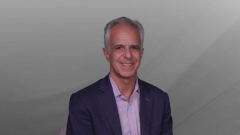
Practical Implications of Increased Utilization of Biosimilars in Practice
Carl D. Regillo, MD, and Jennifer I. Lim, MD, talk about the potential cost savings as well as other real-world implications associated with the use of biosimilars in clinical practice.
Episodes in this series

Carl D. Regillo, MD: What’s the upside? We’re talking about a biologic that’s equivalent. Why use it?
Jennifer I. Lim, MD: It’s cheaper. It’s going to save Medicare. You might say, “It’s a savings of maybe 10%, 20%”—we don’t know yet. You’d say, “That’s not a huge amount,” but with the hundreds of millions of dollars going into anti-VEGFs, you take a chunk. That’s a big chunk of change that can be used in our health care system and is better spent elsewhere.
Carl D. Regillo, MD: They’re approved for common indications; therefore, we utilize them commonly.
Jennifer I. Lim, MD: Exactly.
Carl D. Regillo, MD: In our practice, for sure.
Jennifer I. Lim, MD: Possibly, when other biosimilars come out and they’re shown to be equivalent and are approved—or there might be more—you could see prices go down. With market forces, the price will come down.
Carl D. Regillo, MD: Competition.
Jennifer I. Lim, MD: Which is what we’ve always wanted as retina specialists.
Carl D. Regillo, MD: It’s a good thing. Theoretically, they could be even better and last longer, but probably not. We have these products. How do you think we’re going to use them in practice?
Jennifer I. Lim, MD: Ethically, we must tell our patients what’s available. All the reference drugs and biosimilars—we’re going to tell them about them. I don’t know—I hope not—if insurances would tell us what drug to use. As physicians, that’s our choice. If we feel they’re better served by using drug X because, say, they have a pigment epithelial detachment and other changes where we feel that this drug would work better, we should be able to use it. Then the question comes in: if we pick drug X, then we have to say the biosimilar to drug X because they’re equivalent, and we present that to the patient. It’s going to take some time for physicians to feel comfortable. Over time, with the postmarketing safety, as long as that’s moving in a positive direction and showing no safety signal, there’s going to be more adoption because the price is going to push this forward. People are going to feel comfortable with it.
Carl D. Regillo, MD: At first, it’s going to be a little more challenging for us because, as you say, having choice is a good thing. Ultimately, it will be better, for sure. It’s going to take a little more time with our patients in the chair to talk about options and why we might recommend or choose 1 or another. In the long run, as you said, it’s good to have these choices.
Carl D. Regillo, MD: Jenny, how do you see the landscape changing now that we have new options with biosimilars to treat these common retinal disorders? We’ve got neovascular AMD [age-related macular degeneration], vein occlusions, and so forth.
Jennifer I. Lim, MD: It’s going to be as it was in oncology and in rheumatology. The drugs will come out, the biosimilars will be approved, and we’ll see a slow uptake initially. As physicians and patients become more comfortable, the use is going to go up. That’s what’s going to happen. It’s going to impact cost as well, as other biosimilars come out, as we suggested, and the cost of the reference products may come down. It may come down because of market forces. Perhaps the use of the reference products is going to decrease.
Carl D. Regillo, MD: That could very well happen. There’s 1 thing about the reference products right now in our space: we’ve gotten used to prefilled syringes. Every new product, whether it’s a new biologic or a biosimilar, usually comes out in a vial. That will evolve too, right?
Jennifer I. Lim, MD: Right.
Carl D. Regillo, MD: That might also influence how we choose or how fast they’re adopted, right?
Jennifer I. Lim, MD: True. I remember when the prefilled syringe came out. That was my choice because you wouldn’t think it saves you that much time, but it does.
Carl D. Regillo, MD: There’s no proved safety advantage, but theoretically there is.
Jennifer I. Lim, MD: There’s that too.
Carl D. Regillo, MD: There’s less manipulation. Many of us will state that preference to manufacturers: if they have a product in a vial, also consider prefilled syringe. Ease of use, efficiencies, and so forth. When that happens, that’s going to help speed up adoption over time.
Jennifer I. Lim, MD: Absolutely. As we’re doing, we’re chatting about biosimilars. We need to chat with our colleagues. This discussion must keep going so that the education rolls out for the physicians and those patients get comfortable. There are some patient education campaigns that happen. The positive framing. The whole office is on the same page so that we’re not just saying something. Rather, the technicians, the front desk, the people who are helping with the patient are on board. They might ask, “What do you think about this new biosimilar?” Everybody must be educated in the office so they realize that these have the same safety, efficacy, and potency as the reference drug.
Carl D. Regillo, MD: When we see problems, it’s up to us as the treating clinicians to report them, right?
Jennifer I. Lim, MD: Absolutely. It goes for the reference or the biosimilar drug.
Carl D. Regillo, MD: That’s how we’ll know and get comfortable over time, and we hope that safety is maintained.
Jennifer I. Lim, MD: Absolutely, Carl.
Transcript edited for clarity
Newsletter
Don’t miss out—get Ophthalmology Times updates on the latest clinical advancements and expert interviews, straight to your inbox.
















































